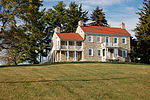Nathan VanMetre House
Berkeley County, West Virginia Registered Historic Place stubsGreek Revival houses in West VirginiaHouses completed in 1872Houses in Berkeley County, West VirginiaHouses on the National Register of Historic Places in West Virginia ... and 1 more
National Register of Historic Places in Berkeley County, West Virginia

Nathan VanMetre House is a historic home located near Martinsburg, Berkeley County, West Virginia. It was built in 1872, and is a two-story, eight bay wide rectangular brick house with a steeply pitched gable roof, in the Greek Revival style. The main section of the house is five bays wide. Also on the property is a small brick smokehouse (1872), large bank barn (1872), garage (c. 1920), two silos (c. 1915 and c. 1920), and chicken house (c. 1920).It was listed on the National Register of Historic Places in 1994.
Excerpt from the Wikipedia article Nathan VanMetre House (License: CC BY-SA 3.0, Authors, Images).Nathan VanMetre House
Dry Run Road,
Geographical coordinates (GPS) Address Nearby Places Show on map
Geographical coordinates (GPS)
| Latitude | Longitude |
|---|---|
| N 39.485833333333 ° | E -77.987777777778 ° |
Address
Dry Run Road 706
25403
West Virginia, United States
Open on Google Maps









